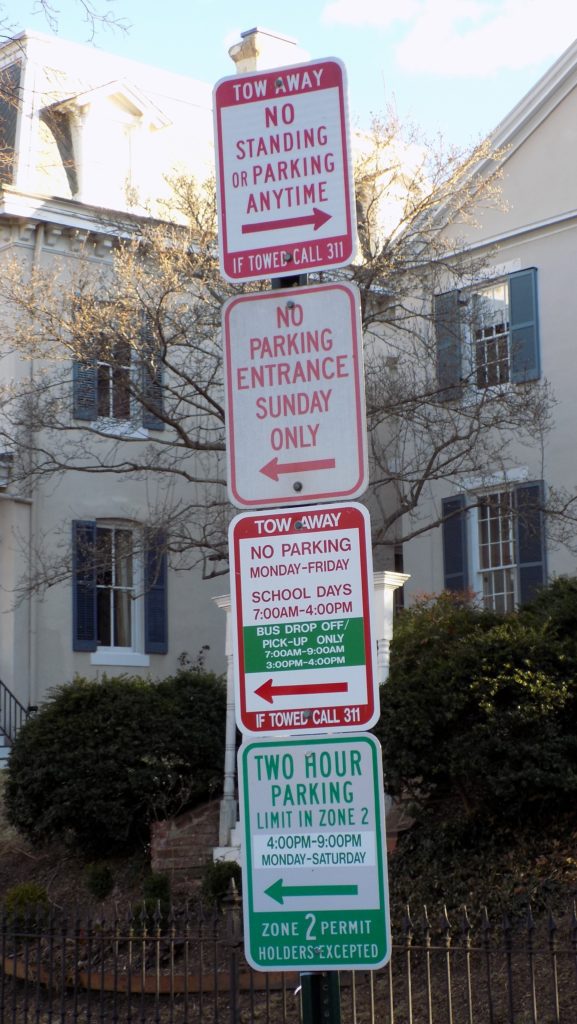By Peggy Sands and Robert Devaney
One-Sided Parking Sparks Lively Debate at ANC
The topics of parking and traffic flows have often triggered heated exchanges at Georgetown community meetings. The discussions at such meetings, generally long, rarely result in measurable progress toward a concrete solution. This was again the case at the monthly meeting of Advisory Neighborhood Commission 2E on Feb. 26.
As someone at the meeting offered during the discussions, such proposals seem like “a solution in search of a problem.”
The commission devoted over an hour to two proposals by Commissioners Jim Wilcox and Peter Murphy. The hall at Visitation School was standing room only. At least a dozen Georgetown residents made impassioned remarks.
Wilcox had hoped that the meeting would “move the process forward.” His idea was to pass a parking resolution that would be an official notice of intent to the District Department of Transportation. That would then impel DDOT to hold town meetings on specific issues in the notice, leading to written options that could be approved or rejected.
Wilcox’s resolution suggested that a program called Enhanced Resident Preferred Parking be implemented in specific sections of Georgetown’s mixed commercial and residential areas. Three parking “sectors” were delineated on a map of Georgetown.
Sector one would cover the shopping corridors of M Street and Wisconsin Avenue and one block to either side, where a split parking system would be established. A two-hour paid parking system for everyone would take up one side of the street. On the other, exclusive unlimited parking for Zone 2 resident parking permit holders would be implemented.
Sector two would be made up of generally residential streets that lie east and west of Wisconsin Avenue, starting at Prospect and Olive Streets and going up to Dent and Q Streets. This sector would convert from unlimited parking for Zone 2 permit holders — with others able to park for up to two hours — on both sides to having that arrangement on one side only. On the other, parking would be exclusively for permit holders.
The rest of Georgetown would be sector three, in which the current parking situation would remain as it is.
The split-sided system exists in other parts of the city and has worked very well, according to Wilcox. But it was the piece that received the most heated comments.
The problem is that D.C.’s Ward 2 ranges from Georgetown, Dupont Circle, Foggy Bottom, downtown and to parts of Kalorama — even the White House — and from the memorials to Hains Point. People who don’t reside in Georgetown itself would be entitled to use the exclusive unlimited one-side parking for residents.
Billy Martin, owner of Martin’s Tavern on the corner of Wisconsin Avenue and N Street, has seen many parking plans come and go. He was opposed to Wilcox’s notice of intent. “There are lots of concerns and controversial questions in it, a lot is not there,” he said.
Debbie Winsor felt the proposal encompassed many “unintentional consequences.” She suggested expanding a community parking coalition that had been meeting for years to address it.
“A notice of intent is whatever you want to make of it,” concluded Ron Lewis, a former advisory neighborhood commissioner and member of the original parking coalition. But he seemed to feel that it was a good tool to stimulate intense community discussion.
Commissioner Peter Murphy introduced a one-page resolution proposing that the ANC 2E take no position at this time concerning implementation of Wilcox’s proposal. Instead, Murphy requested that DDOT “provide, if reasonably available,” a list of information for the commissioners regarding the parking proposal — mainly numbers.
Murphy asked for the estimated number of parking spaces that would be reserved for exclusive use of Zone 2 permit holders if the three sectors were to be implemented. He asked for the estimated number of vehicles that would bear the Zone 2 stickers during the day and how many parking spaces in ANC 2E were currently available for vehicles without Zone 2 stickers. In addition, he asked for an analysis of the impact on certain residential areas.
“There are numbers you would think we already had,” Murphy commented to The Georgetowner afterward.
Within minutes, the commission voted down Wilcox’s proposed notice of intent and approved of the Murphy resolution. Some observers said afterwards that it was a kind of progress.
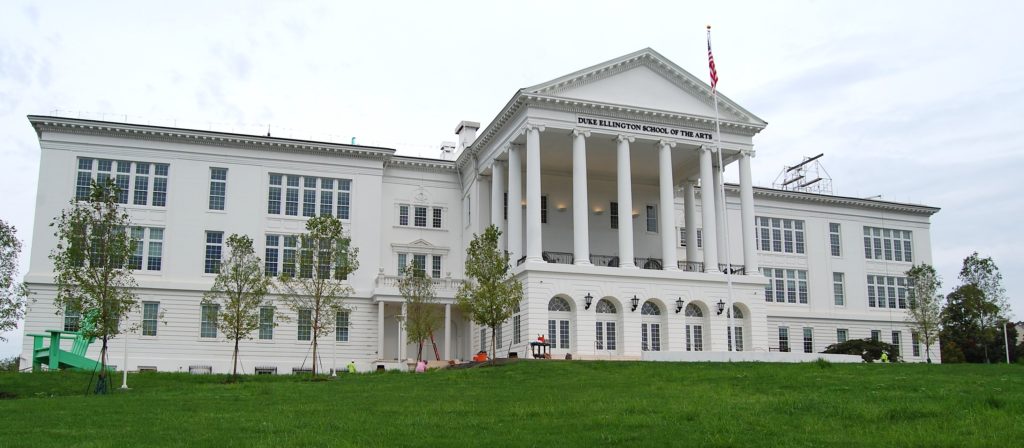 Latest School Scandal Hits Georgetown
Latest School Scandal Hits Georgetown
The D.C. school system saw two resignations in five days last month, following the revelation that Deputy Mayor for Education Jennifer Niles (resignation number one, on Feb. 16) had enabled the daughter of Public Schools Chancellor Antwan Wilson (resignation number two, on Feb. 20) to bypass the fraught DCPS lottery system and obtain an immediate midterm transfer from the Duke Ellington School of the Arts to Woodrow Wilson High School.
Former Chancellor Wilson settled for a severance package of six months of his annual salary of $280,000.
Now there is another enrollment scandal, this time directly connected to the Duke Ellington School. On Feb. 28, the Office of the State Superintendent of Education reported that more than half of a sample of about 100 Duke Ellington students who claimed to reside in the District actually live outside it. By claiming District residency, they are able to avoid the magnet school’s annual out-of-District tuition of $12,000.
D.C. students are given priority for scholarships and admission. Of the school’s 566 enrolled students, about 70 pay the out-of-District tuition.
Hundreds of thousands of dollars in back tuition could be due from the families making the false claims, using addresses of relatives or temporary residences in the District as their child’s primary residence.
The stunningly renovated and expanded Duke Ellington School, at 35th and R Streets on the edge of Georgetown, serves students from all wards of the city. Students are admitted to one of eight arts majors through an audition and interview process. But since reopening last year, the school has struggled to reach its goal of about 600 students.
The state superintendent’s office has promised to review all the applications and stated residences of Duke Ellington students and to try any cases of enrollment fraud.
This scandal comes on top of a third that has roiled the District for months. It was found that a large proportion of graduating students at some D.C. high schools had not attended the minimum number of days or failed to meet other requirements for their degrees.
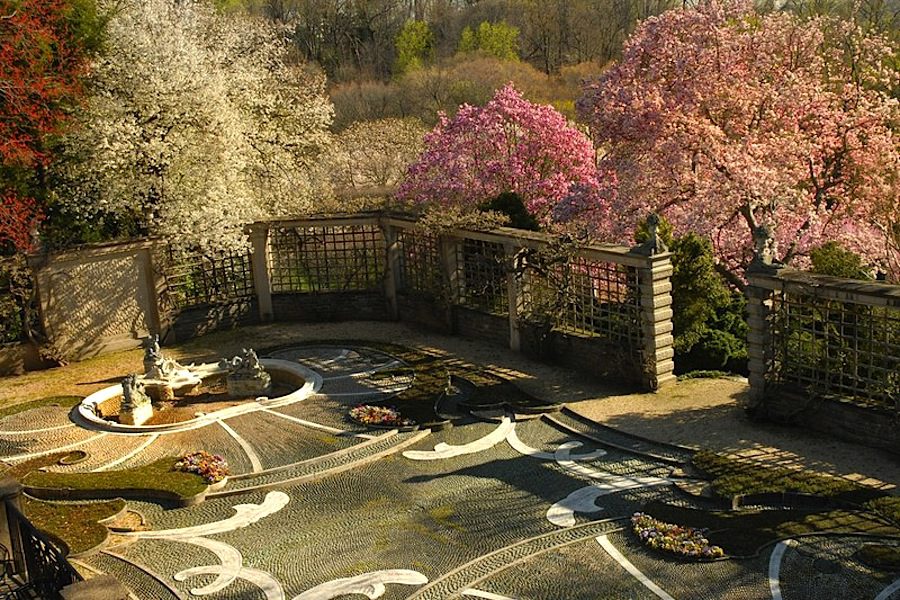 Dumbarton Oaks Gardens Reopening March 15
Dumbarton Oaks Gardens Reopening March 15
After being closed since July of last year, the world-famous gardens at the Dumbarton Oaks estate at 32nd and R Streets in Georgetown will reopen March 15.
“There will be no ceremony, no champagne,” said Gail Griffin, director of gardens and grounds for the past 21 years. “You know, we’re very low-key around here. We’ll just be opening the gates.”
It will be a day of mixed feelings for Griffin, the day she retires from her job overseeing the care of the historic gardens and related research programs and projects. Succeeding her will be D.C. native Jonathan Kavalier, formerly management and program analyst for the Architect of the Capitol and supervisory horticulturist at the Smithsonian Gardens.
The gardens were closed to undertake major restructuring of the water supply and storm water management systems. Miles of pipes have been laid or repaired to provide for irrigation and for the gardens’ ponds, fountains and water-box spigots.
The 10 acres of gardens were designed by Beatrix Farrand, sole female founder of the American Society of Landscape Architects, along with Mildred Barnes Bliss, who had purchased the 1801 estate in 1920 with her husband, diplomat Robert Woods Bliss. There are some 29 garden “rooms” and such features as an orangery, a box wall, star and pebble gardens, arbor and urn terraces and a lovers’ lane.
The Blisses gave what is formally known as Dumbarton Oaks Research Library and Collection to Harvard University in 1940. The collection focuses on Byzantine and Pre-Columbian art, displayed in a pavilion designed by Philip Johnson. In addition, mixed-media works and works on paper by Martha Jackson Jarvis are current on view. Another exhibition, “Seeing Cherries,” opens in the rare book gallery on March 14.
Hungarian pianist Dénes Vàrjon will perform as part of the Music at Dumbarton Oaks concert series on March 18 and 19.
A grand opening for the reconstructed gardens is being planned for April, according to Erica Bogese, communications manager.
OBITUARIES
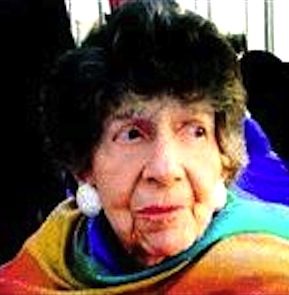 Joan Shorey (1926–2018)
Joan Shorey (1926–2018)
Joan Burgess Shorey, Chicago-raised, 91 years old, lived in Georgetown since 1984. She was the widow of Ev Shorey, with whom she had shared her life in marriage for 63 years. An artist, she attended Vassar College and the Harvard Graduate School of Design. She was an unforgettable presence in the neighborhood, known for her volunteer and charity work and as an active member of the Citizens Association of Georgetown, which her husband served as president.
She was a mother, a grandmother, a warm and keenly intelligent member of the community. Georgetown was and remains known for its history, for an atmosphere of class. Exemplifying that reputation, Ev and Joan Shorey were its standard-bearers, in a way that was without affectation but full of affection. It was always a pleasure to see one or the other or both.
Joan Shorey died Feb. 20. A memorial service will be held in early May.
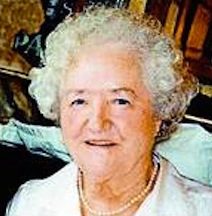 Odette Pantelich (1920–2018)
Odette Pantelich (1920–2018)
Born in France, Odette Louise Galmard Pantelich emigrated to the U.S. after World War II. First employed as a domestic by diplomat David K.E. Bruce, she later married Vojislav “Voya” Pantelich, with whom she opened the landmark Chez Odette restaurant in the early 1950s at 3063 M St. NW. In the mid-1970s, the couple sold the restaurant, which maintained its name and French style until it closed in 1987. They retired to travel and Florida. Voya died in 1981; Odette died Jan. 7 at the Thomas Circle Residences on Massachusetts Avenue NW.
A service will be arranged at a later date at the Saint Nicholas Cathedral in Washington, D.C. Memorial contributions may be made in Odette Pantelich’s name to these charities: Sasha Bruce Youthwork, St. Jude Children’s Research Hospital and the Humane Society of the United States.

